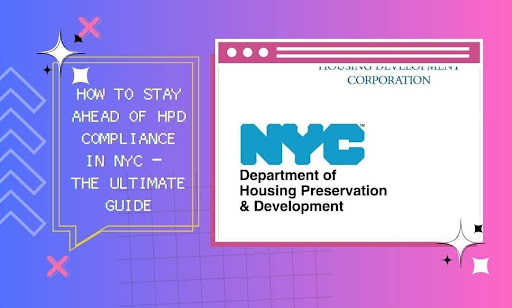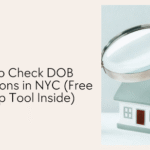Every building has a story. But in New York City, violations tell it louder than the bricks. The Department of Housing Preservation and Development (HPD) doesn’t wait for excuses. One late registration. One ignored tenant complaint. One overlooked inspection—and the penalties snowball. Fast.
So here’s the real question: Are you leading your compliance, or scrambling to fix it?
HPD enforcement isn’t about what you know. It’s about what you track, fix, file, and prove—on time, every time. And staying ahead? That’s not luck. It’s a process. You’re in the right place if you’re done reacting and ready to run a building that doesn’t bleed fines. This isn’t theory. It’s the framework NYC operators use to stay clean, stay open, and stay profitable. Let’s get into it.
Stay Informed or Fall Behind—There’s No In-Between

Compliance issues don’t come out of nowhere. They build—quietly, slowly—until they show up on your doorstep in the form of a violation you could’ve prevented. The first—and most overlooked—step to staying ahead of HPD compliance is knowing what’s required before it turns into a penalty. That means keeping your ear to the ground. Always.
Let’s break it down:
Regularly Review HPD Guidelines
HPD doesn’t run on autopilot. Rules shift. Requirements change. Enforcement priorities evolve. What was acceptable last year might trigger a violation this year. That’s why reviewing current HPD codes isn’t optional—it’s the baseline.
You’ll want to:
- Check the HPD website for updates at the start of every quarter
- Watch for Local Law amendments that affect your building classification
- Join compliance alerts from trusted NYC housing organizations
- Download the latest version of the Housing Maintenance Code, then actually read it
Even one missed update can cost you. This is where most managers get blindsided.
Understand What Applies to Your Building
Not every HPD rule applies to every property. That’s where smart operators separate from the pack. Know your building’s classification and how it impacts:
- Registration requirements
- Inspection cycles
- Violation tiers (A, B, or C violations)
- Applicable safety and maintenance laws
For example, a six-unit pre-war walk-up in Brooklyn won’t carry the same filing obligations as a 30-unit elevator building in the Bronx. The rules are specific. You have to match them to your actual structure, occupancy, and usage.
Pro tip? Build a compliance cheat sheet that aligns with your exact building specs. Update it quarterly.
Track Every Deadline Like It’s Rent Day
Deadlines don’t care how busy your schedule is. If you forget to file—even once—HPD penalties stack fast. Here’s what you should track with non-negotiable precision:
- Annual Property Registration (due every year between May 21 and September 1)
- Lead-based paint inspection and disclosure filings (based on tenant age and lease status)
- Annual boiler inspections and certifications
- Heating season requirements and complaint tracking
- Smoke and carbon monoxide compliance filings
Don’t rely on memory. Build a calendar system that works without you having to think about it. The second it’s manual it’s flawed.
Use the Right Tools to Stay Current
Knowledge is currency—but only if it’s current.
Keep your compliance toolkit sharp with:
- HPD Online and Building Registration portals
- City housing resource newsletters
- Internal compliance tracking spreadsheets
- Google Calendar alerts for recurring filings
- On-site inspection logs that get updated weekly
This isn’t busywork. It’s the groundwork that keeps violations off your record and your name out of HPD reports.
If you get this part wrong, everything else becomes a cleanup job.
Don’t Wait for a Violation to Knock
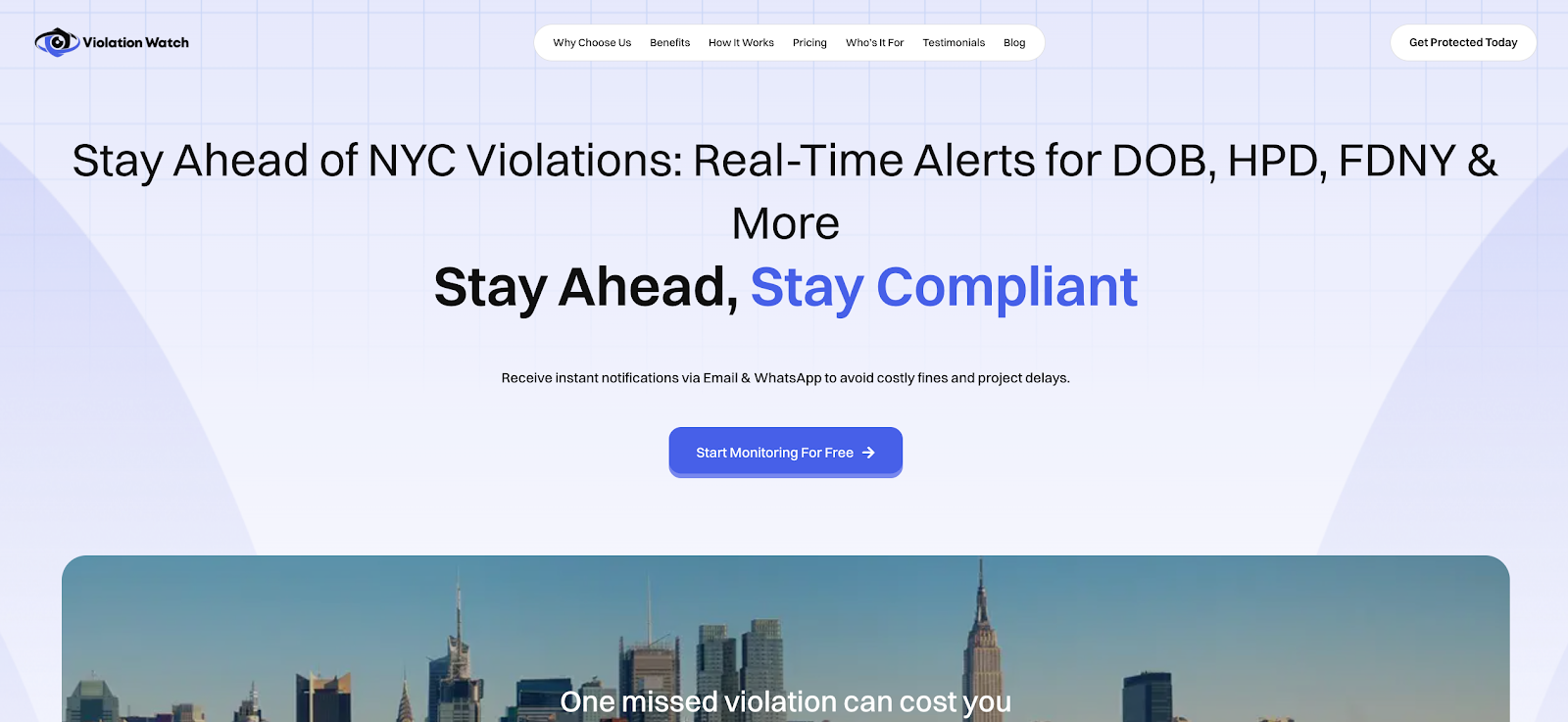
Staying informed is your foundation. But it’s not enough. Knowing the rules won’t shield you from violations if your building’s failing in real time. You need to act early, regularly, and without waiting for someone to tell you what’s wrong. This is where proactive measures matter.
Inspect Your Own Property—Often
If you’re not scheduling formal internal inspections every month, you’re operating blind. HPD inspections are unannounced. Yours shouldn’t be. Structured walkthroughs allow you to catch and document issues before they become official violations. And no—it’s not enough to send a porter with a checklist.
You need a rotation that hits every critical area:
- Common areas: Check lighting, stair treads, door self-closers, and mailbox locks
- Apartments: Rotate through occupied units quarterly (legally accessible with notice), checking for peeling paint, rodent droppings, missing smoke or CO detectors
- Basements and mechanical rooms: Look for signs of leaks, unsecured gas lines, open electrical panels, and expired inspection tags
- Roof: Confirm guardrails, bulkhead locks, and proper drainage
Each finding should be logged with a timestamp, photos, and the name of the staff member responsible for follow-up. Store this audit trail somewhere permanent. If HPD inspects and you have zero documentation, your response won’t hold up at a hearing.
Address Complaints Like They’re Lawsuits
HPD complaints don’t reflect the tenant’s tone—they reflect your building’s risk.
You’re legally required to resolve certain issues within specific timeframes. For example:
- Class A violations (non-hazardous): 90 days
- Class B violations (hazardous): 30 days
- Class C violations (immediately hazardous): 24 hours
If a tenant files a 311 complaint and HPD opens a case, your building is instantly on record. Whether the problem was “minor” doesn’t matter. If they send an inspector and it’s still unresolved? You’re facing a fine, possible litigation, and a black mark on your compliance record.
Here’s what a professional complaint response system looks like:
- Centralized intake – All complaints funnel through one designated email or software
- Response window – Acknowledge receipt within 12–24 hours
- On-site verification – A trained staff member inspects the issue, preferably the same day
- Corrective action – Immediate scheduling of repairs or maintenance
- Documentation – Photos, invoices, and work logs stored in an organized system
Treating complaints casually is how Class B issues escalate into Class C violations with civil penalties. Treat every complaint as if it’s already in court—and build a paper trail accordingly.
Stay on Top of Registration Every Year
HPD requires every residential building with three or more units—or private homes with a tenant and neither the owner nor managing agent living on-site—to submit Annual Property Registration between May 21 and September 1.
Missing this deadline invalidates your legal standing in housing court and makes it illegal to collect rent in some scenarios. Let that sink in.
What causes most rejections?
- Owner info that doesn’t match DOF or DOB records
- Incomplete managing agent fields (must be a NYC resident or business with a NYC address)
- Missing emergency contact info for after-hours issues
- Registration not notarized, or using outdated forms
- Submission made, but payment never posted to HPD
Each building’s registration must be renewed every year, even if nothing has changed. It’s not a one-and-done task. Smart owners tie this deadline to a system reminder, assign it to a specific staff member, and verify receipt using the HPD Registration Summary Report. Anything less is asking for fines.
Maintain Clean, Accessible Records
You don’t win hearings by explaining. You win with documentation. Period. HPD requires owners to maintain access to a wide range of records. When you’re audited, they don’t want your “intent”—they want your logs, certificates, and dated entries.
The bare minimum you need on file includes:
- Annual boiler inspection reports (with proof of timely filing to the DOB)
- Lead paint disclosure and inspection documentation (Local Law 1 compliance)
- Pest control treatment logs (quarterly or monthly, depending on past violations)
- Smoke/CO detector installation affidavits and battery replacement logs
- Work orders and invoices tied to HPD-related repairs
- Tenant complaint records, including timestamps, resolutions, and follow-ups
- Elevator inspection certificates (if applicable), posted and filed
All documents should be organized digitally and backed up. Physical binders fall apart in audits. Without proof, every claim becomes a “he said, she said”—and HPD sides with the inspector every time.
Call in Professional Help (But Be Careful)
Some owners bring in compliance consultants or violation expediters. That’s smart—until it’s not.
These professionals can draft filings, track deadlines, and even attend administrative hearings on your behalf. But here’s the truth no one likes to admit:
- Most charge a retainer, then bill hourly
- Some outsource filings to low-cost processors who cut corners
- Others disappear when things get messy, especially when HPD pushes back
- And unless you review their work personally, you won’t know there’s a problem until a violation shows up with your name on it
The worst part? You’re still liable for every error. Hiring someone doesn’t remove your responsibility. It just shifts the blame after you’ve already paid. If they miss a filing, you eat the fine. If they file wrong, you pay to fix it. So yes, professional help can be valuable. But only if you can afford high retainers, vet every document they touch, and audit their work regularly. That’s not freedom. That’s overhead.
That’s exactly why you need a system built to track, alert, and guide without expensive middlemen. This is where ViolationWatch enters. A smarter tool built specifically for NYC compliance—without the high-stakes guessing game.
Why ViolationWatch Is the Smartest Way to Stay Ahead of HPD Compliance
You can set calendar reminders. Hire consultants. Even build internal systems from scratch. But if you’re still juggling spreadsheets, city portals, and 3 AM text alerts from your supers, you’re playing catch-up, not staying ahead.
Property owners know the risk—missing a single violation notice from any of the city agencies tied to housing enforcement can lead to steep fines, building-wide audits, or worse. Most of these violations happen not because the owner fails to act, but because the information comes too late.
And when compliance deadlines pass without response, the cost keeps rising. Whether it’s the New York City Department of Housing Preservation and Development flagging overdue registrations or the DOB cracking down on lead-based paint hazards in residential units, every overlooked rule puts your ability to ensure compliance on the line.
ViolationWatch flips that entire model on its head. It’s not another task on your list. It’s the one tool that watches every violation across all major NYC agencies and tells you what matters—before it hits your wallet.
Here’s How It Works in Simple Steps:
- Sign up and add your properties: Enter each NYC address you want monitored. The system syncs to city databases in seconds.
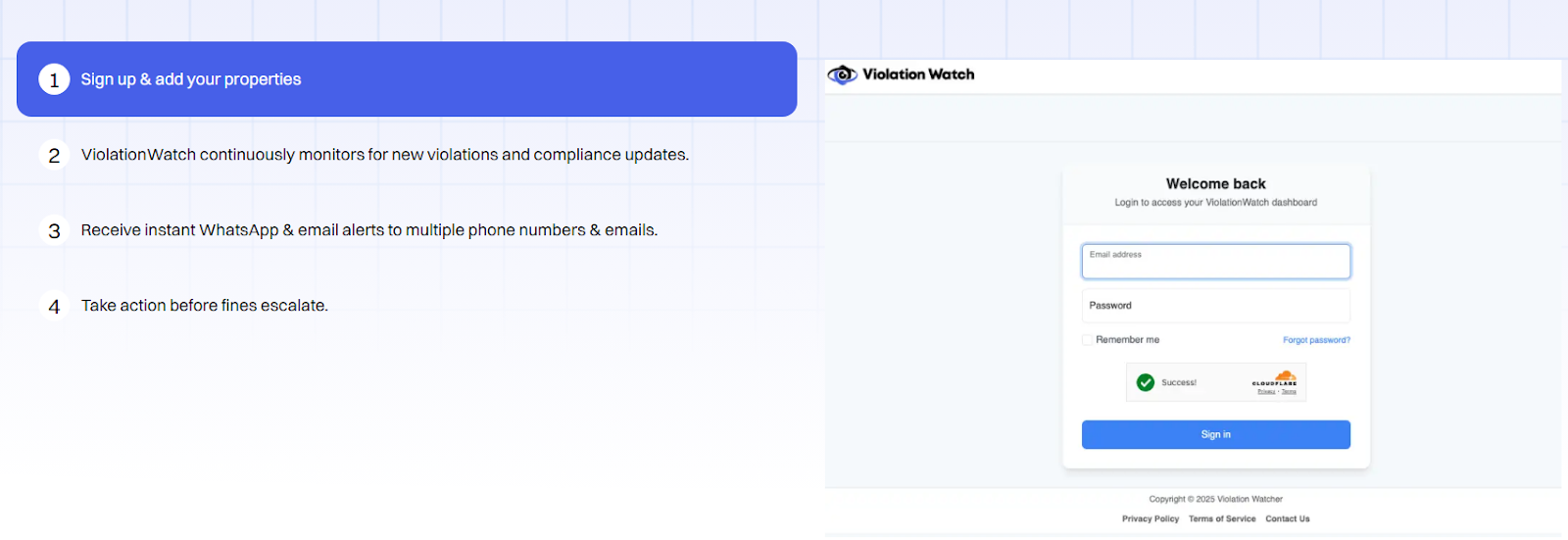
- Let ViolationWatch do the monitoring: It continuously pulls updates across HPD, DOB, ECB, FDNY, DEP, and more. New violations. Status changes. Compliance updates. Nothing slips through.
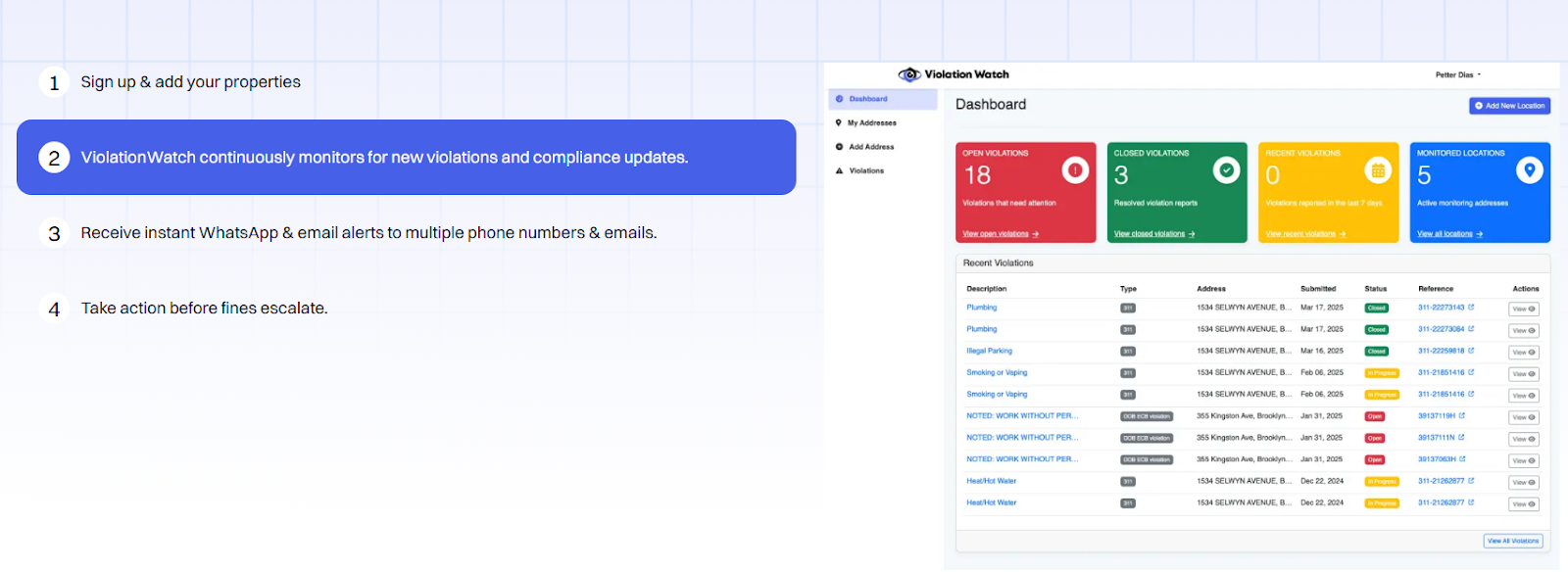
- Get alerts the moment something changes: WhatsApp, email, SMS—you pick how you want to be notified. You can even assign alerts to different team members based on address or role.
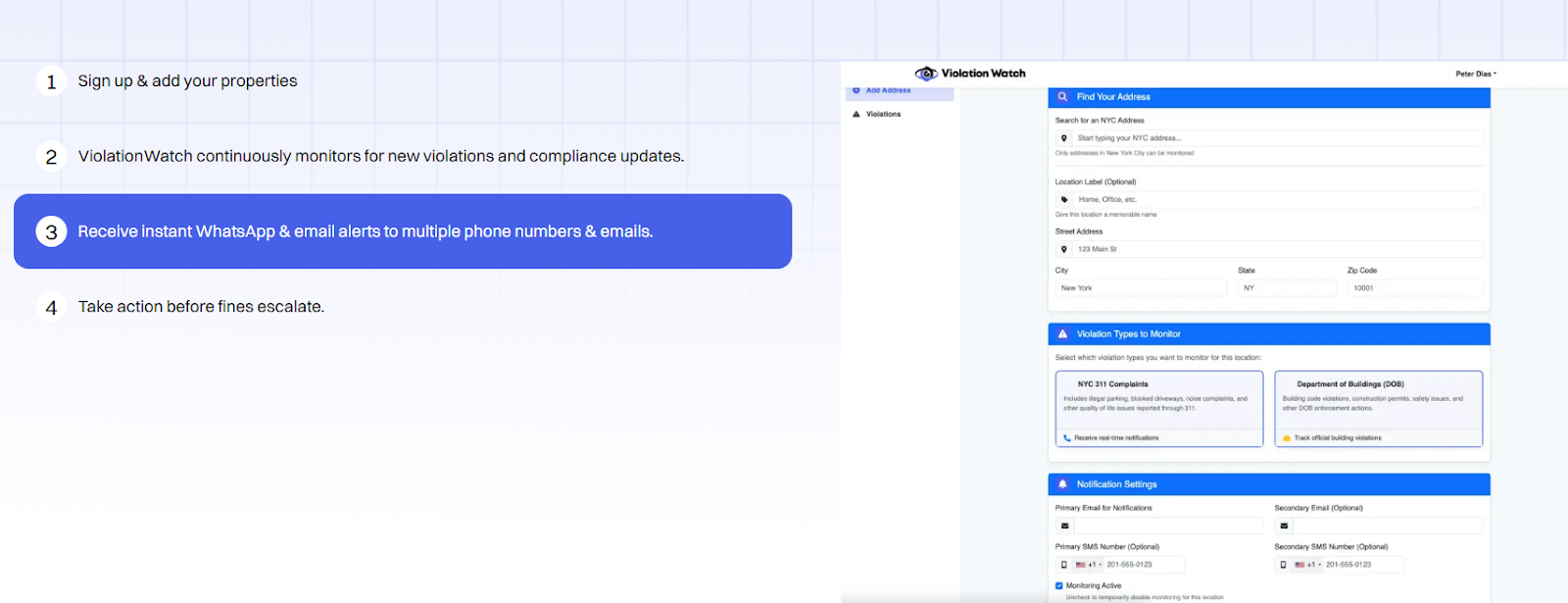
- Act fast—before the fine escalates: Open violations are flagged in your dashboard with status, type, and agency source. Click. Review. Resolve. No more guessing what to prioritize.
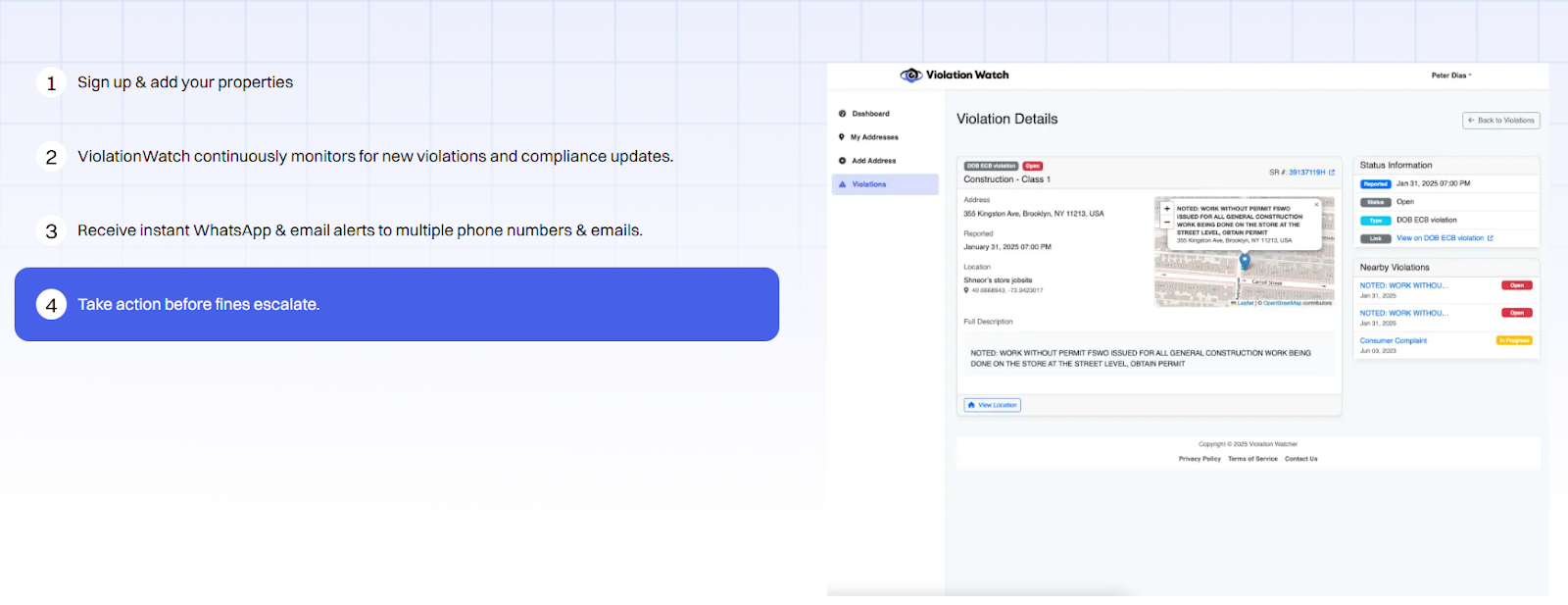
Real Compliance Control Without the Consultant Fees
You’re not locked into long contracts or high retainers. ViolationWatch gives you two options:
| Plan | Price | Key Features |
| Free Trial | $0/month | 1 location, limited to 311 violations, delayed alerts (48-hour lag), single contact |
| Full Monitoring Plan | $9.99/month per address | Unlimited violation & compliance tracking, real-time alerts, full access to all original records, team notifications, multi-location dashboard |
No credit card required to start. No fine print. You can test it on one address for free, and scale when you’re ready.
With ViolationWatch, you’re not reacting to compliance problems—you’re cutting them off before they become liabilities. That’s how you stay ahead of HPD. Not with paperwork. With precision.
Where Violations Actually Start—And How to Stay Ahead of Them
Knowing the rules isn’t enough. Neither is tracking deadlines nor hiring pros. If you’re not laser-focused on the specific zones where HPD violations originate, you’re playing defense after the fact. These zones aren’t random. They’re repeat offenders. The same categories trigger the majority of enforcement, and they’re fully preventable if you stay on top of them.
Let’s get into the zones that matter.
Annual Registration
It’s a basic requirement, but it still trips people up. If your registration isn’t current—or filed with the correct ownership and managing agent info—you’re already out of compliance.
Mistakes that lead to rejection:
- Wrong owner mailing address
- Agent listed without a valid NYC address
- Missing emergency contact
- Unnotarized or expired forms
The system doesn’t forgive technicalities. If it’s not done right, it’s not done at all. And once you’re off the HPD radar, every other filing becomes a problem.
Complaint Timelines and Response
HPD responds to 311 complaints within strict timelines. You should, too. Most violations start with tenant calls. If a tenant complains about heat, hot water, pests, or a broken fixture and you don’t act fast, HPD will. And once they’re involved, you’ve lost control of the timeline.
Your complaint management must be:
- Logged with timestamps
- Verified with an on-site check
- Closed out with proof of repair
- Documented clearly enough to show in court if needed
Anything less puts you in violation territory—even if the work gets done later.
Lead Paint Compliance
If your building was built before 1960—or between 1960 and 1978 with known lead paint—you’re subject to Local Law 1.
That means:
- Annual inspections in units with children under six
- Proper documentation of visual assessments
- Use of certified contractors for any abatement work
- Safe work practices (no dry sanding, no heat guns, etc.)
Lead violations are considered Class C. They carry some of the highest penalties and enforcement urgency. Keep documentation on file and updated annually, even if no work was done.
Heat and Hot Water
Between October 1 and May 31, you’re legally required to maintain minimum temperatures during specific hours. Water must stay at a certain temp year-round. Tenants don’t need to give you notice. They call 311 once, and you’re inspected the next day.
To stay compliant:
- Monitor boilers daily during the heat season
- Log delivery times for heating oil or gas
- Install digital thermostats or remote sensors in common areas
- Keep backup systems or technician access lined up in case of an outage
Losing heat during a cold snap isn’t an inconvenience. It’s a liability with immediate HPD response.
Smoke and CO Detectors
These are required in every dwelling unit—no exceptions. Most violations come from one of two causes:
- Missing or expired devices
- Improper placement (too close to vents or windows)
You must install, test, and maintain smoke detectors and carbon monoxide alarms at your own expense. Tenants are required to maintain them, but if they don’t, you still get the fine unless you have signed notices showing the device was present and working when the lease started.
Keep installation affidavits on file. Replace batteries during routine maintenance. And check every unit at least once a year.
Window Guards
In any unit with children under 11, window guards aren’t optional.
They must be:
- Installed on every window except fire escapes
- In good condition, without rust or looseness
- Documented in tenant lease riders and annual notices
Failure to comply can result in serious liability, especially if there’s an accident. Even if no children currently live in the unit, if a tenant didn’t return the annual notice, you’re expected to install them by default. Track who received the form, who returned it, and what action you took.
Essential Services Maintenance
This covers everything from locks on lobby doors to lighting in stairwells to pest control in public areas. If it’s part of the tenant’s right to safe, livable conditions, it qualifies as essential.
You’re expected to:
- Keep lighting functional in all common areas
- Secure main entrances and fire doors
- Remove debris, standing water, and pest attractants
- Maintain intercoms, mailboxes, and hallway ventilation
Any breakdown in these areas triggers enforcement, especially during building-wide audits or follow-up inspections tied to unrelated complaints.
Stay sharp in these zones. They’re not random. They’re patterns—and once you know where violations grow, you can stop them before they start.
Stay Ahead of HPD Compliance Without Losing Sleep Over It
Staying compliant in NYC isn’t about luck—it’s about precision. And when you’ve got a system that works, the results speak for themselves.
Apply what we’ve covered, and here’s what changes:
- You’ll stop guessing about HPD rules. You’ll know what applies, what’s due, and what’s changed—before it becomes a violation.
- Instead of reacting to complaints, you’ll prevent them. Inspections get logged. Repairs get done. Paperwork backs it all up.
- You won’t scramble to fix smoke alarms, submit boiler reports, or file registrations at the last minute. You’ll be ahead. Every time.
- No more frantic calls, lost documents, or last-minute attorney fees. You’ll run a building that doesn’t trip into fines every quarter.
That’s not just compliance. That’s control. And if you want to keep that control without hiring more staff, micromanaging supers, or gambling with third-party consultants, ViolationWatch is the system that makes it doable. One dashboard. Instant alerts. Actual visibility into everything that puts your buildings at risk. Because staying ahead of HPD compliance shouldn’t drain your time—or your budget.
Recommended For You
Need help tracking violations, getting alerts, or managing multiple properties?
Sign up for updates from NYC agencies or rely on compliance monitoring tools to keep you in the loop.

